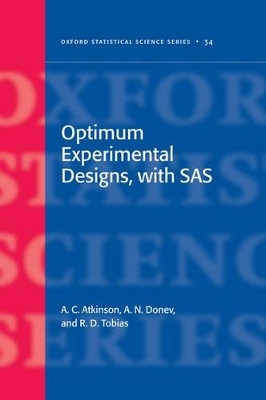
Optimum Experimental Designs, With SAS
Oxford University Press (Verlag)
978-0-19-929659-0 (ISBN)
Experiments on patients, processes or plants all have random error, making statistical methods essential for their efficient design and analysis. This book presents the theory and methods of optimum experimental design, making them available through the use of SAS programs. Little previous statistical knowledge is assumed. The first part of the book stresses the importance of models in the analysis of data and introduces least squares fitting and simple optimum experimental designs. The second part presents a more detailed discussion of the general theory and of a wide variety of experiments. The book stresses the use of SAS to provide hands-on solutions for the construction of designs in both standard and non-standard situations. The mathematical theory of the designs is developed in parallel with their construction in SAS, so providing motivation for the development of the subject. Many chapters cover self-contained topics drawn from science, engineering and pharmaceutical investigations, such as response surface designs, blocking of experiments, designs for mixture experiments and for nonlinear and generalized linear models. Understanding is aided by the provision of "SAS tasks" after most chapters as well as by more traditional exercises and a fully supported website. The authors are leading experts in key fields and this book is ideal for statisticians and scientists in academia, research and the process and pharmaceutical industries.
Preface ; I BACKGROUND ; 1. Introduction ; 2. Some key ideas ; 3. Experimental strategies ; 4. The choice of a model ; 5. Models and least squares ; 6. Criteria for a good experiment ; 7. Standard designs ; 8. The analysis of experiments ; II THEORY AND APPLICATIONS ; 9. Optimum design theory ; 10. Criteria of optimality ; 11. D-optimum designs ; 12. Algorithms for the construction of exact D-optimum designs ; 13. Optimum experimental design with SAS ; 14. Experiments with both qualitative and quantitative factors ; 15. Blocking response surface designs ; 16. Mixture experiments ; 17. Nonlinear models ; 18. Bayesian optimum designs ; 19. Design augmentation ; 20. Model checking and designs for discriminating between models ; 21. Compound design criteria ; 22. Generalized linear models ; 23. Response transformation and structured variances ; 24. Time-dependent models with correlated observations ; 25. Further topics ; 26. Exercises ; Bibliography ; Author index ; Subject index
| Erscheint lt. Verlag | 7.6.2007 |
|---|---|
| Reihe/Serie | Oxford Statistical Science Series ; 34 |
| Zusatzinfo | numerous line figures |
| Verlagsort | Oxford |
| Sprache | englisch |
| Maße | 173 x 247 mm |
| Gewicht | 1005 g |
| Themenwelt | Mathematik / Informatik ► Mathematik |
| Medizin / Pharmazie ► Pharmazie | |
| Studium ► Querschnittsbereiche ► Epidemiologie / Med. Biometrie | |
| Technik ► Umwelttechnik / Biotechnologie | |
| ISBN-10 | 0-19-929659-6 / 0199296596 |
| ISBN-13 | 978-0-19-929659-0 / 9780199296590 |
| Zustand | Neuware |
| Informationen gemäß Produktsicherheitsverordnung (GPSR) | |
| Haben Sie eine Frage zum Produkt? |
aus dem Bereich


